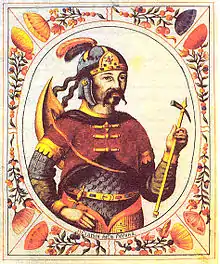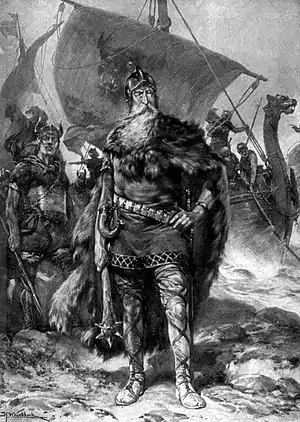Rurik
Rurik of Ladoga (also Ryurik;[1] Old East Slavic: Рюрикъ Rjurikŭ, from Old Norse Hrøríkʀ; Belarusian: Рурык; Russian, Ukrainian: Рюрик; c. 824–879), according to the 12th-century Primary Chronicle, was a Varangian chieftain of the Rus' who in the year 862 was invited to reign in Novgorod. He is considered to be the founder of the Rurik dynasty, which went on to rule Kievan Rus' and its principalities, and then the Tsardom of Russia, until the death of Feodor I in 1598. Vasili IV, who reigned until 1610, was the last Rurikid monarch of Russia.[2]
| Rurik | |
|---|---|
| Prince of Novgorod | |
 Rurik on the monument "Millennium of Russia" in Veliky Novgorod. | |
| Reign | 862–879 |
| Successor | Oleg |
| Born | c. 824 Scandinavia |
| Died | 879 (aged 54–55) Novgorod, Kievan Rus' |
| Issue | Igor |
| Dynasty | Rurik |
Life
The only surviving information about Rurik is contained in the 12th-century Primary Chronicle written by one Nestor, which states that Chuds, Eastern Slavs, Merias, Veses, and Krivichs "drove the Varangians back beyond the sea, refused to pay them tribute, and set out to govern themselves". Afterwards the tribes started fighting each other and decided to invite the Varangians, led by Rurik, to reestablish order. Rurik came in 860–862 along with his brothers Sineus and Truvor and a large retinue.

According to the Primary Chronicle, Rurik was one of the Rus', a Varangian tribe, likened by the chronicler to Swedes and Gotlanders. The scholarly consensus[3] is that the Rus' people originated in what is currently coastal eastern Sweden around the eighth century and that their name has the same origin as Roslagen in Sweden (with the older name being Roden).[4][5] According to the prevalent theory, the name Rus', like the Proto-Finnic name for Sweden (*Ruotsi), is derived from an Old Norse term for "the men who row" (rods-) as rowing was the main method of navigating the rivers of Eastern Europe, and it could be linked to the Swedish coastal area of Roslagen (Rus-law) or Roden, as it was known in earlier times.[6][7] The name Rus' would then have the same origin as the Finnish and Estonian names for Sweden: Ruotsi and Rootsi.[7][8] Sineus established himself at Beloozero and Truvor at the town of Izborsk. Truvor and Sineus died shortly after the establishment of their territories, and Rurik consolidated these lands into his own territory.
According to the entries in the Radzivil and Hypatian Chronicles[9] under the years 862–864, Rurik's first residence was in Ladoga. He later moved his seat of power to Novgorod, a fort built not far from the source of the Volkhov River. The meaning of this place name in medieval Russian is 'new fortification', while the current meaning ('new city') developed later.
Rurik remained in power until his death in 879. On his deathbed, Rurik bequeathed his realm to Oleg, who belonged to his kin, and entrusted to Oleg's hands his son Igor, for he was very young. Oleg moved the capital to Kiev (by murdering the then-rulers and taking the city) and founded the state of Kievan Rus', which was ruled by Rurik's successors (his son Igor and Igor's descendants). The state persisted until the Mongol invasion in 1240.
Legacy

The Rurik dynasty (or Rurikids) went on to rule Kievan Rus', and ultimately the Tsardom of Russia, until 1598, and numerous noble families in the former lands of Kievan Rus' claim male-line descent from Rurik. The last Rurikid to rule Russia was Tsar Vasily IV (from the House of Shuysky, cadet branch of the House of Rurik), who reigned until 1610. The Romanovs were also related to descendants of Rurik. They were related to Rurik through marriage. The descendants of the princely families allegedly inherited from Rurik are still living.[10]
As there are no remains of Rurik, the DNA of Rurik himself cannot be studied. The Y chromosomes of people thought to be the modern descendants of Rurik are often a subset of haplogroup N, traditionally called N1c and now known as N1a. Since then, the same N1c form has been found in other princely families descended from Rurik. These families are called Rurikids. However, not all the supposed descendants of Rurik have it.[10]
Alternative Theories

The name Rurik is a form of the Old Norse name Hrœrekr.[11] Rorik of Dorestad was a member of one of two competing families reported by the Frankish chroniclers as having ruled the nascent Danish kingdom at Hedeby. He may have been a nephew of king Harald Klak. He is mentioned as receiving lands in Friesland from Emperor Louis I. He started to plunder neighbouring lands: he took Dorestad in 850, attacked Hedeby in 857, and looted Bremen in 859, while his own lands were ravaged in his absence. The Emperor was enraged and stripped him of all his possessions in 860. After that, Rorik disappears from western sources for a considerable period of time. In 862, according to the Russian sources, Rurik arrived in the eastern Baltic and built the fortress of Ladoga. Later he moved to Novgorod.
Rorik of Dorestad reappeared in Frankish chronicles in 870, when his Friesland demesne was returned to him by Charles the Bald. In 882 Rorik is mentioned as being dead (without a date of death specified). The Russian chronicle places the death of Rurik of Novgorod in 879, three years earlier than the Frankish chronicles. According to western sources, the ruler of Friesland was converted to Christianity by the Franks. This may have parallels with the Christianization of the Rus' reported by Patriarch Photius in 867.
The idea of identifying Rurik of Rus' with Rorik of Dorestad was revived by the anti-Normanists Boris Rybakov and Anatoly H. Kirpichnikov in the mid-20th century,[12] but Alexander Nazarenko and other scholars have objected to it.[13] The hypothesis of their identity currently lacks wide support among scholars,[14] though support for a Viking/Norse rather than Slavic origin of Rus' has increased.
References
- HARRIS, ZENA; RYAN, NONNA (2004). "The Inconsistencies of History: Vikings And Rurik". New Zealand Slavonic Journal. 38: 105–130. ISSN 0028-8683. JSTOR 40922182.
- Christian Raffensperger and Norman W. Ingham, "Rurik and the First Rurikids", The American Genealogist, 82 (2007), 1–13, 111–119.
- "The Vikings at home". History Extra. 24 September 2012. Retrieved 26 February 2021.
- Mark, Joshua J. (3 December 2018). "Kievan Rus". World History Encyclopedia.
- Sorabella, Jean (October 2002). "The Vikings (780–1100)". Heilbrunn Timeline of Art History. New York: Metropolitan Museum of Art. Retrieved 26 February 2021.
- Blöndal, Sigfús (1978). The Varangians of Byzantium. Cambridge University Press. p. 1. ISBN 9780521035521. Retrieved 2 February 2014.
- Stefan Brink, "Who were the Vikings?', in The Viking World, ed. by Stefan Brink and Neil Price (Abingdon: Routledge, 2008), pp. 4–10 (pp. 6–7).
- "Russ". Oxford English Dictionary (Online ed.). Oxford University Press. Retrieved 25 July 2018. (Subscription or participating institution membership required.)
- Ipat’ievskaia letopis’ 1962:14; Radzivilovskaia letopis’ 1989:16
- Kalmistopiiri, julkaissut (27 October 2021). "Ruhtinas ja ruhtinaan pojat – paljastavatko geenit Venäjän perustajana pidetyn Rurikin alkuperän?". KALMISTOPIIRI (in Finnish). Retrieved 3 September 2022.
- Omeljan Pritsak, "Rus'", in Medieval Scandinavia: An Encyclopedia, ed. Phillip Pulsiano (New York: Garland, 1993), pp. 555–56.
- Kirpichnikov, Anatoly H. "Сказание о призвании варягов. Анализ и возможности источника". Первые скандинавские чтения, СПб; 1997; ch. 7–18.
- Nazarenko, Alexander. "Rjurik и Riis Th., Rorik", Lexikon des Mittelalters, VII; Munich, 1995; pp. 880, 1026.
- Andrei Mozzhukhin (5 October 2014). «Рюрик — это легенда» ["Rurik – is a legend"]. Russian Planet (in Russian). Retrieved 12 November 2014. Interview with Igor Danilevsky.
Further reading
- Bibliography of the history of the Early Slavs and Rus'
- Bibliography of Russian history (1223–1613)
- List of Slavic studies journals


.svg.png.webp)